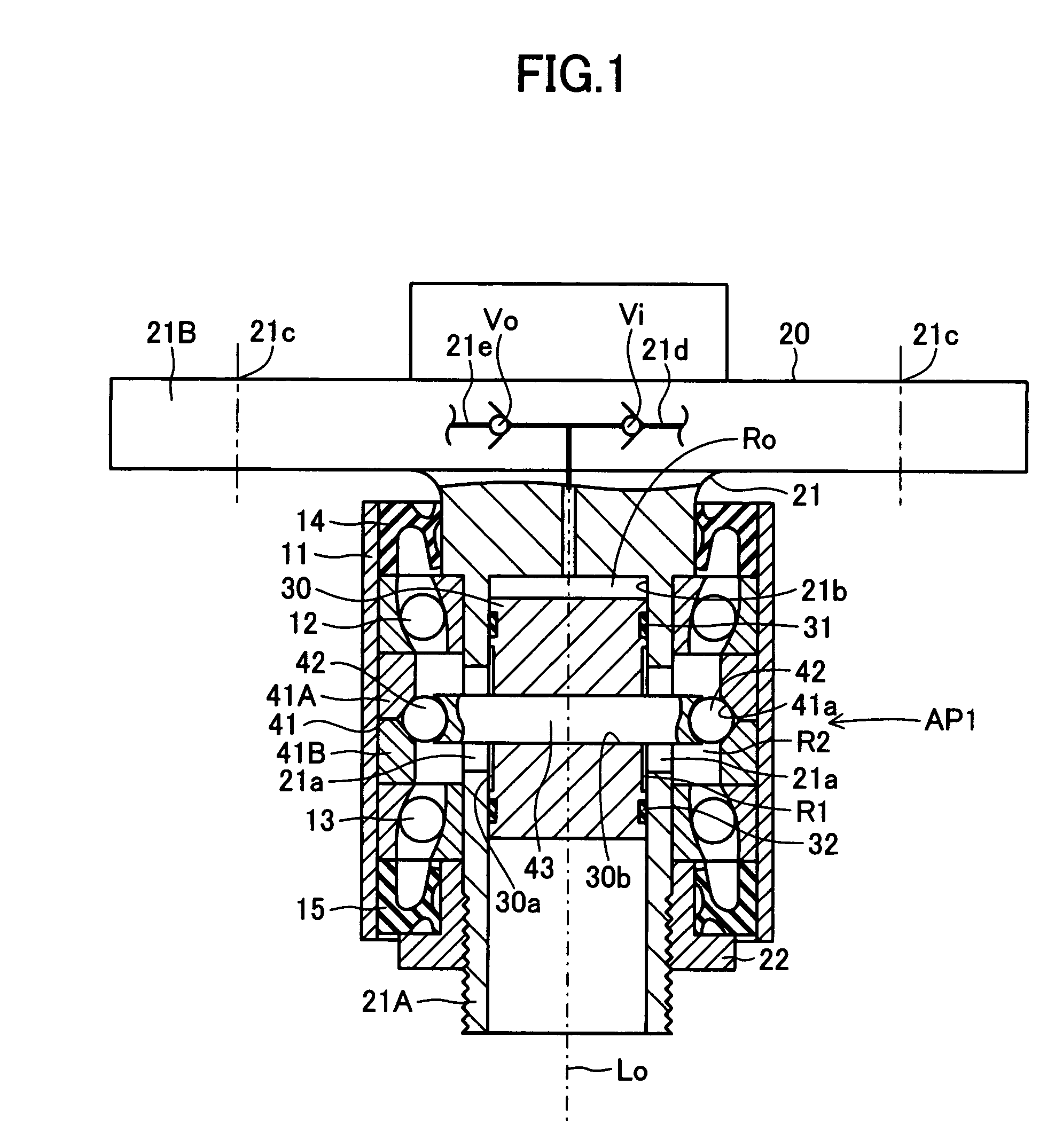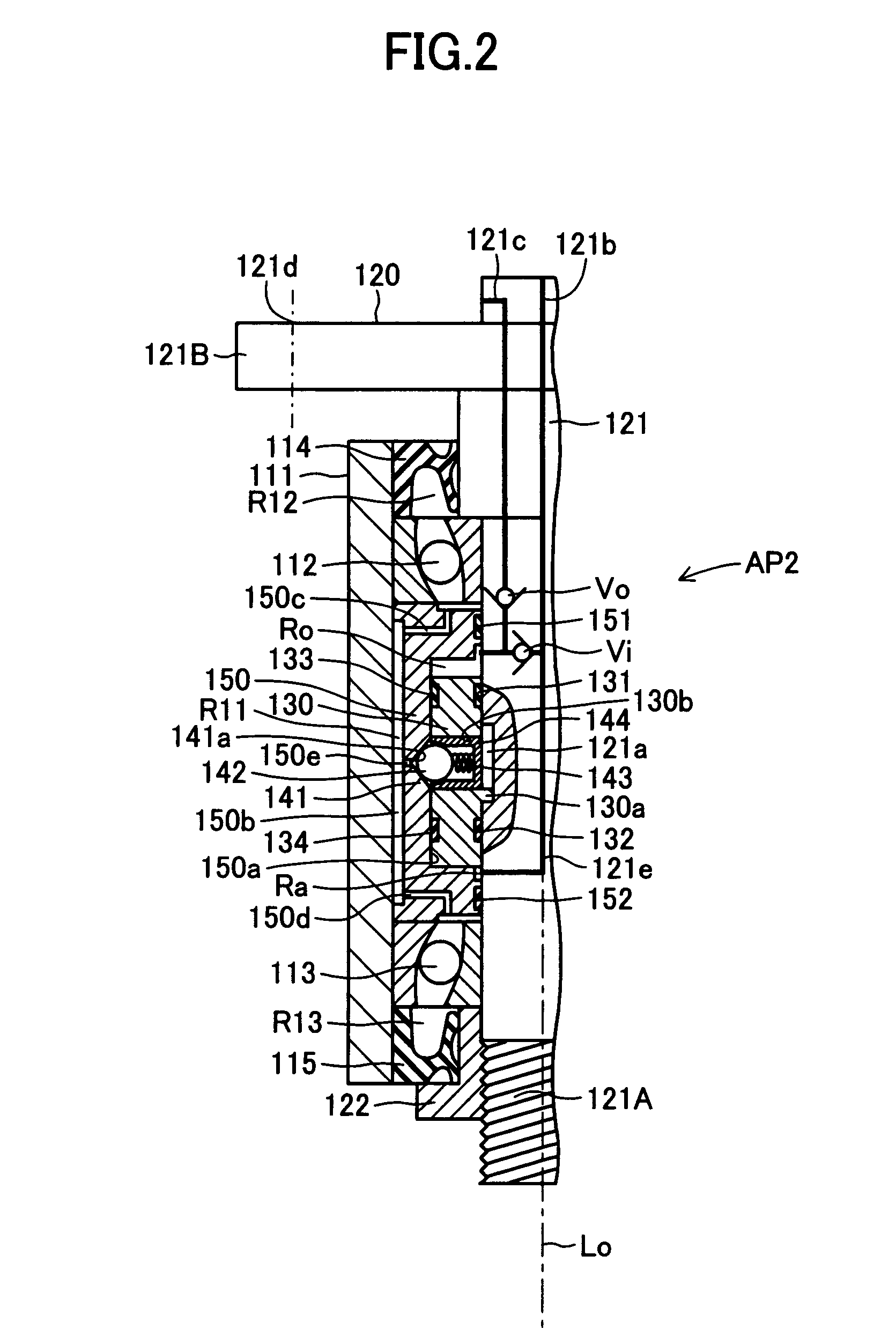Pressure generation device
a pressure generation device and pressure generation technology, applied in the direction of positive displacement liquid engine, piston pump, gasket, etc., can solve the problems of increasing poor mounting in the vehicle, and difficulty in reducing so as to reduce the size and cost reduce the size of the pressure-generating device, and reduce the effect of effective utilization
- Summary
- Abstract
- Description
- Claims
- Application Information
AI Technical Summary
Benefits of technology
Problems solved by technology
Method used
Image
Examples
first embodiment
In the thus-configured pressure-generating device AP1 of the first embodiment, when the axle hub 20 rotates in relation to the cylindrical support portion 11, the piston 30, the rod 43, and the cam followers 42 rotate unitarily with the axle hub 20 and make relative rotation in relation to the cam member 41 to thereby move axially. Accordingly, the rotary motion of the axle hub 20 can be converted to the reciprocating motion of the piston 30. The reciprocating motion of the piston 30 can increase and decrease the volume of the pump chamber Ro. Thus, air can be introduced into the pump chamber Ro through the suction path 21d in which the suction check valve Vi is installed, and air can be discharged from the pump chamber Ro through the discharge path 21e in which the discharge check valve Vo is installed. The discharged air (pressurized air) can be supplied into the tire air chamber (not shown) of a wheel attached to the axle hub 20.
In the pressure-generating device AP1 of the first ...
second embodiment
In the thus-configured pressure-generating device AP2 of the second embodiment, when the axle hub 120 rotates in relation to the cylindrical support portion 111, the piston 130 and the cam follower 142 rotate unitarily with the axle hub 120 and make relative rotation in relation to the cylindrical cam 141 to thereby move axially. Accordingly, the rotary motion of the axle hub 120 can be converted to the reciprocating motion of the piston 130. The reciprocating motion of the piston 130 can increase and decrease the volume of the pump chamber Ro. Thus, air can be introduced into the pump chamber Ro through the suction path 121b in which the suction check valve Vi is installed, and air can be discharged from the pump chamber Ro through the discharge path 121c in which the discharge check valve Vo is installed. The discharged air (pressurized air) can be supplied into the tire air chamber (not shown) of a wheel attached to the axle hub 120.
In the pressure-generating device AP2 of the se...
third embodiment
The third embodiment has air chambers R22 (see FIG. 5), which collectively serve as a volume-change-reducing means for reducing a change in volume of the annular space R21 associated with the reciprocating motion of the two pistons 230. The air chambers R22 decrease in volume as the volume of the annular space R21 decreases, and increase in volume as the volume of the annular space R21 increases. The air chambers R22 are implemented by respective air bags 250, which are attached to the outer circumference of the rotary shaft portion 221A in a unitarily rotatable manner. The air bags 250 are formed from an elastic, airtight material such as rubber and confine compressed air therein. The air bags 250 shrink as the inner pressure of the annular space R21 increases in association with a reduction in volume of the annular space R21, and inflate as the inner pressure of the annular space R21 drops in association with an increase in volume of the annular space R21. This reduces the magnitu...
PUM
 Login to View More
Login to View More Abstract
Description
Claims
Application Information
 Login to View More
Login to View More - R&D
- Intellectual Property
- Life Sciences
- Materials
- Tech Scout
- Unparalleled Data Quality
- Higher Quality Content
- 60% Fewer Hallucinations
Browse by: Latest US Patents, China's latest patents, Technical Efficacy Thesaurus, Application Domain, Technology Topic, Popular Technical Reports.
© 2025 PatSnap. All rights reserved.Legal|Privacy policy|Modern Slavery Act Transparency Statement|Sitemap|About US| Contact US: help@patsnap.com



